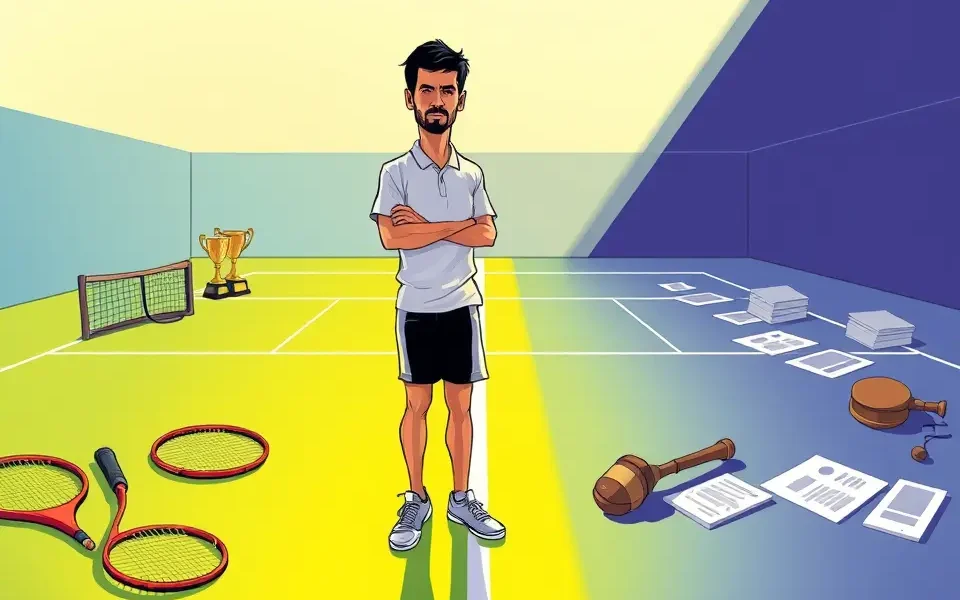The Professional Tennis Players Association (PTPA), co-founded by Novak Djokovic and Vasek Pospisil, has recently filed a high-profile antitrust lawsuit against the major governing bodies of professional tennis. This action has sent ripples throughout the tennis world, raising questions about player compensation, working conditions, and the overall structure of the sport. While Djokovic is a prominent figure behind the PTPA, his exact position on the lawsuit is nuanced, and this article delves into his real stance, the motivations behind the lawsuit, and the potential implications for the future of tennis.
The PTPA’s Legal Offensive: Why Sue?
The PTPA’s lawsuit targets what it perceives as deep-seated issues within the professional tennis landscape. The lawsuit names the ATP (men’s tour), WTA (women’s tour), ITF (International Tennis Federation), and ITIA (International Tennis Integrity Agency) as defendants, accusing them of anti-competitive practices and a disregard for player welfare. Here’s a breakdown of the core grievances:
- Financial Restrictions: The lawsuit argues that the governing bodies “cap the prize money tournaments award and limit players’ ability to earn money off the court.” The PTPA believes that players are not receiving a fair share of the sport’s revenues.
- Player Exploitation: The PTPA accuses the ATP, WTA, ITF, and ITIA of exploiting tennis players, jeopardizing their health and safety through unsustainable schedules and disregard for player well-being.
- Monopolistic Control: The lawsuit aims to end the “monopolistic control” the governing bodies have over professional tennis, arguing that their setup constitutes “textbook violations of state and federal law” that “immunize professional tennis from ordinary market forces and deny professional tennis players and other industry participants their right to fair competition.”
- Unfair System: The PTPA contends that players are trapped in an unfair system that exploits their talent, suppresses their earnings, and jeopardizes their health and safety.
- Lack of Transparency: The PTPA was born out of a perception that the ATP was not adequately protecting the interests of its players, particularly regarding transparency in decision-making.
Specifically, the lawsuit highlights issues such as:
- An Unsustainable Schedule: The PTPA argues that the demanding 45-week-per-year schedule, along with the increased number of combined WTA-ATP events lasting 12 days, negatively impacts player health.
- Inadequate Compensation: The lawsuit seeks to increase player earnings, arguing that the current system does not allocate enough of the sport’s revenue to the athletes.
- Restrictive Ranking System: The PTPA criticizes the ranking system for restricting which events players can enter, limiting their opportunities.
- Overly Strict Anti-Doping Measures: The lawsuit describes the International Tennis Integrity Agency’s approach as “heavy-handed,” “arbitrary and selective,” and alleges abuse of players’ privacy rights through random drug tests.
- Player Welfare: The lawsuit underscores that player welfare is completely disregarded in everything, from the tour schedule to anti-competitive practices, to abusing players’ rights around name, image, likeness.
Djokovic’s Position: A Balancing Act
While Djokovic is a co-founder of the PTPA and a vocal advocate for player rights, his stance on the current lawsuit is not entirely straightforward. In a press conference at the Miami Open, Djokovic stated that while he agrees with some aspects of the lawsuit, he also disagrees with others, even expressing discomfort with the language used.
Here are the key takeaways from Djokovic’s statements:
- Qualified Support: Djokovic acknowledges that there are elements of the lawsuit he supports, indicating his alignment with the PTPA’s broader goals of improving player welfare and creating a fairer system.
- Disagreement on Specifics: He also states that he disagrees with certain aspects of the lawsuit, suggesting that the PTPA’s approach may not entirely reflect his personal views.
- Concerns about Tone: Djokovic specifically mentioned that he found some of the wording in the lawsuit “quite strong,” implying that he prefers a more measured approach.
- Empowering Other Players: Djokovic has stated that he intentionally did not include his name on the legal action to encourage other players to step up and take a stand. He wants to see younger players become more involved in advocating for their rights.
- Limited Control: While Djokovic sits on the PTPA’s executive committee, he maintains that he does not have ultimate authority over the organization’s decisions.
Djokovic’s position reflects a balancing act. He is a staunch advocate for player rights and believes that the current system needs reform. However, he also appears to be cautious about the specific tactics employed in the lawsuit and wants to encourage broader player involvement in the movement.
The Reactions: Division and Disagreement
The PTPA’s lawsuit has triggered strong reactions from various stakeholders in the tennis world.
- ATP and WTA: Both the ATP and WTA have issued statements strongly defending their practices and rejecting the PTPA’s claims. The ATP has accused the PTPA of “division and distraction,” while the WTA has labeled the lawsuit “baseless” and “misguided,” asserting they have “committed to a $400 million increase in player compensation” in recent years.
- Other Players: Responses from other players have been mixed. Carlos Alcaraz distanced himself from the lawsuit, stating he was unaware of it and does not support it. Nick Kyrgios, on the other hand, called it a “special moment” for players’ voices to be heard. Ons Jabeur, a member of the PTPA’s executive committee, has publicly supported the lawsuit and outlined specific issues she believes need to be addressed, including scheduling, match times, and player compensation. Coco Gauff and Aryna Sabalenka have expressed interest in seeing players receive a larger share of tournament revenue.
- Tennis Community: The lawsuit has sparked widespread debate within the tennis community, with some observers praising the PTPA for challenging the status quo and others questioning the merits of its legal strategy.
What’s Next? Potential Outcomes and Implications
The PTPA’s lawsuit is still in its early stages, and its ultimate outcome is uncertain. Here are some potential scenarios and their implications:
- Settlement: The governing bodies could choose to settle the lawsuit out of court. This could lead to changes in prize money distribution, scheduling, and other aspects of player welfare.
- Court Victory for PTPA: If the PTPA wins the lawsuit, it could force significant reforms in the way professional tennis is governed, potentially leading to a more player-centric system.
- Court Victory for Governing Bodies: If the ATP, WTA, ITF, and ITIA prevail in court, it would likely maintain the status quo and could weaken the PTPA’s influence.
- Prolonged Legal Battle: The lawsuit could drag on for years, creating uncertainty and potentially further dividing the tennis world.
Regardless of the legal outcome, the PTPA’s lawsuit has already had a significant impact by:
- Raising Awareness: The lawsuit has brought greater attention to issues of player compensation, working conditions, and governance in professional tennis.
- Empowering Players: The PTPA’s actions have encouraged players to speak out and demand better treatment.
- Shifting the Dialogue: The lawsuit has forced the governing bodies to address the concerns raised by the PTPA, potentially leading to future reforms, regardless of the legal outcome.
The Road Ahead: A More Equitable Future for Tennis?
The PTPA’s lawsuit represents a pivotal moment in the history of professional tennis. While Novak Djokovic’s precise stance on the legal action is complex, his support for the PTPA’s broader mission is clear. The lawsuit has the potential to reshape the sport, creating a more equitable and sustainable future for players. However, the road ahead is likely to be challenging, with significant opposition from the established governing bodies. Whether the PTPA can achieve its goals remains to be seen, but its efforts have already sparked a much-needed conversation about the future of tennis.








No Comment! Be the first one.